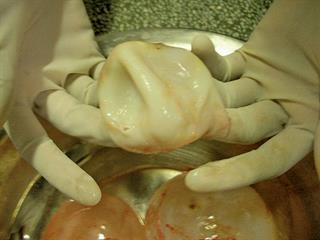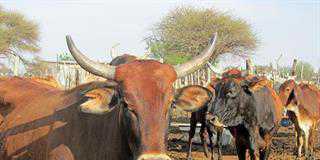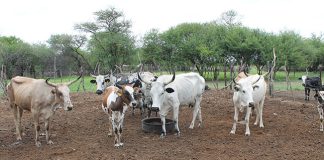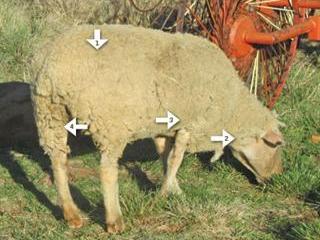
A tapeworm such as Echinococcus granulosus requires two separate hosts – the intermediate host and the final host – to complete its life cycle. The larval stages of the parasite live in a hytadid cyst (a thick-walled sac) in intermediate hosts such as cattle, sheep, goats and wild herbivores. Humans can also accidentally act as an intermediate host, and hydatid disease, or echinococcus, is a serious threat for people living in close contact with animals. The adult tapeworm lives in dogs and wild carnivores such as jackal, hyena, lion and leopard.
Life-cycle
The life-cycle starts when a sheep, goat or bovine swallows tapeworm eggs while grazing contaminated pasture. The eggs hatch in the animal’s small intestine and the larvae pierce the wall of the intestine to enter the blood vessels. They then travel to the liver, lungs and sometimes other organs, where they lodge and form cysts. Huge numbers of larvae develop inside each cyst.
Adult tapeworm
In the next stage of infection, dogs eat infected offal fed to them by their owners (never give your dog uncooked offal to eat!) Once inside the new host, the cysts burst and release the tapeworms, which then travel to the intestine. Here the worms grow to between 2mm and 6mm long. Each consists of:
- a head with hooks and suckers that attach the tapeworm to the wall of the host’s small intestine;
- a neck where growth takes place;
- a body comprising three to seven segments, which produces eggs.
Each segment has both male and female sexual organs, which means that one worm can reproduce on its own. A single segment contains up to 150 eggs. As it fills with eggs, the segment is pushed to the tail of the worm and exits the body. The eggs are then released into the environment with the excreta of the host. Adult tapeworms have little or no effect on dogs, unless they occur in large numbers. Then they cause an enteritis (inflammation of the small intestine) with diarrhoea.
How tapeworm affects the host
There are no outward signs of infection and cysts are found only during meat inspection at abattoirs. In humans, cysts tend to produce jaundice and a large, distended abdomen. If cysts are in the lungs, the person may experience chest pains, fever and shortness of breath. Cysts developing in vital organs such as the heart and brain can cause sudden death.
Control & prevention
- Deworm your dog at least three times/year.
- Cook all meat before giving it to dogs.
- Bury or burn dead animals on the farm as soon as possible to prevent dogs from scavenging these carcasses.
- Make sure that meatis strictly inspected when an animal is slaughtered on the farm and consult a vet immediately if you notice anything abnormal.
- Provide clean pastures for your livestock by controlling stray livestock.
- As humans usually become infected after handling infected dogs, always wash your hands after working or playing with dogs. Remember that your clothes may also be contaminated.
- Regularly remove and bury dog faeces near your home. Use a spade or double plastic bags covering your hands to pick up the faeces.
- Flies can carry eggs from dog faeces to water, food or cooking utensils. Wash utensils thoroughly and control flies, especially in and near the kitchen.
For further information on treatment and prevention, consult your nearest state or private vet or animal health technician.
Source: Animal Health for Developing Farmers, ARC-Onderstepoort Veterinary Institute.













